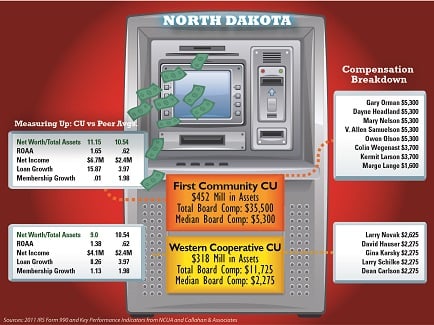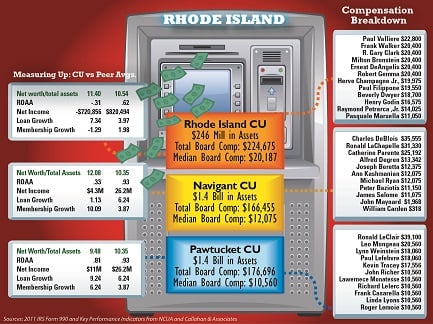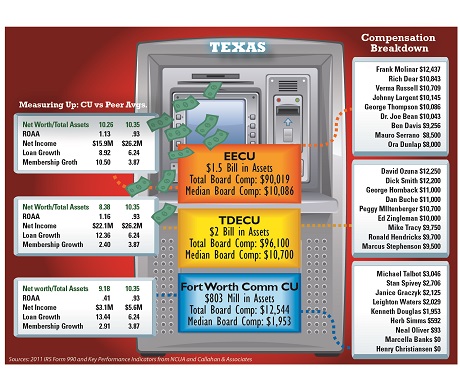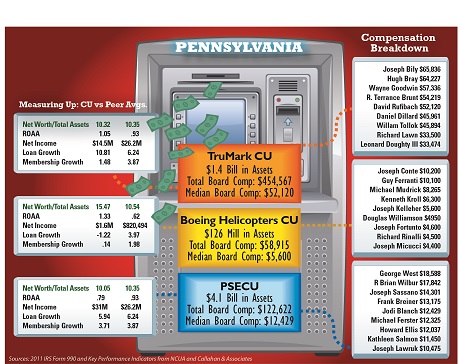 The reaction among the roomful of credit union board members was shock and awe.
The reaction among the roomful of credit union board members was shock and awe.
During the course of CUNA's Credit Union Roundtable for Board Leadership in Chicago last summer, one person said that his credit union chairman was paid $10,000 a year and the vice chairman got $8,000 a year, said Gary Klotz, chair of the $500 million Community Choice Credit Union in Farmington Hills, Mich. “The reaction in the room was almost one of disbelief that they were paying them anything.”
Klotz, a proponent of volunteer boards, was also astonished to find out recently that the $18,000 the two board members received in compensation was modest compared to what dozens of credit union board members in other states received in compensation.
More on Board Director Pay:
Part Two – Liability, Demands Make Pay Necessary
Editorial – Time to Talk Turkey on 'Volunteer Boards'
Only a small percentage of credit unions pay directors in most states that allow board compensation. In Texas, for example, fewer than 20 credit unions, or less than 10% of the state-chartered credit unions, pay board directors. In Nevada, none of its three state-chartered CUs pay their boards. However, all nine state-chartered Rhode Island CUs pay directors, and five of the six state-chartered Maryland CUs also compensate directors.
(Click on each of the graphics below to see expanded versions.)
 What's more, most credit unions pay small stipends that range from a few hundred dollars to $7,000 a year.
What's more, most credit unions pay small stipends that range from a few hundred dollars to $7,000 a year.
But some board members receive considerably more in compensation.
A Credit Union Times review of federal documents shows that a board member at an Indiana credit union received an annual stipend of $93,109 for working two hours a week on board business. A board treasurer at a Pennsylvania credit union made $65,836 annually for spending four hours a week on board work. At a Rhode Island credit union, the board chair made $39,100 for eight hours a week of board work. A board chair at a Maryland credit union got a $25,300 annual stipend for working one hour a week. And a board chair at a Wisconsin credit union received a $21,305 annual stipend for working 10 hours a week on board business.
In addition to Indiana, Pennsylvania, Rhode Island, Maryland and Wisconsin, other states – Georgia, Minnesota, Kentucky, Alabama, New Jersey, Nevada and North Dakota – permit state-chartered credit unions to compensate board members, according to list compiled by CUNA. In Nevada and Wisconsin, officers of the board and committee members are allowed to receive compensation. CUNA did not list Texas, which permits state-chartered credit unions to pay directors a fee for attending board meetings, according to the Texas Credit Union Department.
Arkansas, Colorado, Idaho, Mississippi, Montana and Vermont allow compensation for only the board treasurer, according to CUNA.
 For this article, Credit Union Times compiled charts that list three of the largest state-chartered credit unions from each state that pay their board members. The charts also review how these credit unions performed financially in 2012 compared to their peers to see if they tended to perform any better, any worse or about the same as credit unions in their peer group, the vast majority of which do not pay their board members.
For this article, Credit Union Times compiled charts that list three of the largest state-chartered credit unions from each state that pay their board members. The charts also review how these credit unions performed financially in 2012 compared to their peers to see if they tended to perform any better, any worse or about the same as credit unions in their peer group, the vast majority of which do not pay their board members.
The industry's long-standing debate over whether to pay or not to pay directors has heated up again after state legislators in Tennessee and Washington passed legislation in the spring giving state-chartered credit unions the option to pay board directors. The new laws will become effective in July.
More states will follow suit with similar laws, predicts Lin Hodges, president/CEO of the $1.3 billion Associated Credit Union in Norcross, Ga., because it's difficult to recruit qualified board members. And some CEOs argue it's only right to provide reasonable compensation to directors who are spending more time than ever on credit union business making complicated decisions and facing increased liability risks.
But those who favor a volunteer board say it has successfully worked for decades and exemplifies the credit union difference over banks. Besides, if credit unions pay board members, it may attract those who are only serving for the money, they say.
 Credit Union Times reviewed more than 250 IRS Form 990 documents filed by state-chartered credit unions in 2011. To maintain their tax-exempt status, federal law requires state-chartered credit unions to submit an IRS Form 990 annually to report financial and operational information, including compensation of directors and executives
Credit Union Times reviewed more than 250 IRS Form 990 documents filed by state-chartered credit unions in 2011. To maintain their tax-exempt status, federal law requires state-chartered credit unions to submit an IRS Form 990 annually to report financial and operational information, including compensation of directors and executives
The review found that most state-chartered credit unions do not pay board members. But the IRS Form 990s revealed that many credit unions are paying their board members sizeable stipends for working one to five hours a week on board business, while a few others are working eight, nine or 10 hours a week.
Here are a few samplings gleaned from IRS documents.
In Rhode Island, all nine state-chartered credit unions collectively paid their 100 board members more than $1 million in compensation in 2011.
In Pennsylvania, the $1.4 billion Trumark Financial Credit Union in Trevose, Pa., provides its nine board members with the highest compensation amount in the U.S., paying a total of $452,567. The annual stipends per board member ranged from $33,474 to $65,836, with a median compensation of $52,120.
Eleven board members at the $2.3 billion Teachers Credit Union in South Bend, Ind., received a total of $356,749, with annual stipends ranging from $8,491 to $93,109. The median compensation was $22,350.
The $246 million Rhode Island Credit Union in Providence compensated its 11 board members with a total of $227,045. The annual stipends ranged from $11,050 to $22,800, with the median stipend at $20,187.
In Maryland, the $2.7 billion State Employees Credit Union in Linthicum paid its board of 10 directors a total of $217,462. Annual stipends ranged from $2,500 to $29,060. The median stipend was $22,687.
At the $2 billion Texas Dow Employees Credit Union in Lake Jackson, nine board members received a total compensation of $96,150. Annual stipends were from $9,500 to $12,500, with a median annual stipend of $10,700.
The seven board members at the $1.3 billion Royal Credit Union in Eau Claire, Wis., got compensation totaling $83,075, with annual stipends from $8,670 to $21,305. The median stipend was $10,130.
In Georgia, the 15 board members of the $1.3 billion Associated Credit Union in Norcross were collectively paid $76,000, with stipends from $3,000 to $6,000, and a median board stipend of $5,500.
The $452 million First Community Credit Union in Jamestown, N.D., paid its eight board members a total of $35,500, with stipends from $1,600 to $5,300 and a median annual stipend of $5,300.
And in Minnesota, the nine board members of the $559 million Postal Credit Union in Woodbury received a total compensation of $12,876, with stipends that ranged from $650 to $1,874 and a median annual stipend of $1,479. The state's largest credit union, the $3.9 billion Wings Financial, only paid its board chair, Michael Cooper, a $12,000 stipend in 2011. The other five directors did not receive compensation.
Credit unions in Pennsylvania and Maryland, as well as a few in Texas, Indiana and Wisconsin, paid their board members higher compensation levels than credit unions in Georgia, Minnesota and North Dakota. In Alabama, Kentucky and New Jersey, very few credit unions paid board directors, with compensation ranging from a few hundred dollars to $7,000 annually.
These stipend totals, however, do not include compensation credit unions paid to credit and supervisory committee members. The IRS does not require credit unions to report committee members' compensation because they do not vote on board business.
Some credit union professionals criticized compensation paid to board members in Pennsylvania, Rhode Island, Indiana, Wisconsin and Maryland, arguing the stipends were far too high and questioned what credit unions were getting in return for these sizeable stipends.
“What value are you getting from a board member for $12,000?” asked Richard Odenthal, president/CEO of the $718 million Central Minnesota Credit Union in Melrose. “Paying board members $100 a meeting is not outlandish, but paying a board member $12,000 a year? Then someone may ask what are you doing for that amount of compensation?”
Central Minnesota does not pay its board members though it's been discussed from time to time.
“From my perspective as a CEO, if you compensate them, will you get people who are just in it for the money?” Odenthal asked. “I have worked in the banking world too, and I've seen how that works. Sometimes those [paid board positions] are patronage positions more than anything else.”
Klotz of Community Choice CU questioned what those credit unions are getting in terms of time commitment and expertise that justifies that kind of money.
“They must be spending an awful lot of time on credit union activities,” he said. “But you have to ask, what are they doing? Are they functioning as a board or are they functioning as super managers?”
Most of the credit unions in their IRS 990 forms reported board members, on average, work one to four or five hours a week on board business. A few other credit unions reported board members worked eight to 10 hours a week.
Of the 26 CEOs at credit unions that pay board members contacted by Credit Union Times, eight agreed to interviews. The other CEOs either declined an interview or did not respond to interview requests.
The CEOs interviewed said their boards are made up of professionals such as small business owners, certified public accountants, lawyers, executives, real estate developers, insurance brokers and doctors who leverage their expertise and talents that keep the credit union financially sound and help it grow.
Details of what the CEOs had to say will appear next week in part two of this article.
© Touchpoint Markets, All Rights Reserved. Request academic re-use from www.copyright.com. All other uses, submit a request to [email protected]. For more inforrmation visit Asset & Logo Licensing.








